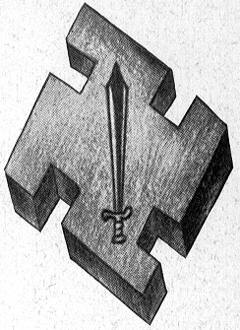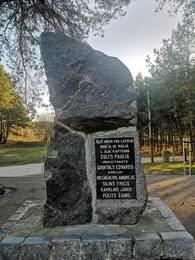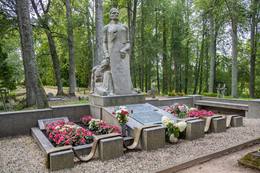Independent Student Company I Wars of Independence

A separate student company was founded on December 20, 1918. The creation of student jewelry is an important event in the history of Latvia. It was a time when the state of Latvia had just been established. With patriotism at the heart of the students, young people united to defend their country.
Latvia's independence was proclaimed on November 18, 1918, but the real power in Latvia belonged to the German occupation institutions, which did everything to hinder the work of the Provisional Government. The caretaker government was weak, with no money or other material resources. In mid-November 1918, Red Army units began moving west to gain control of Eastern Europe.
The Latvian student corporations "Selonija" and "Talavija" began to take active steps to defend the Provisional Government of the newly formed Latvian state and the idea of its own state. On November 23, 1918, a meeting of Latvian students was held at the Vila Olava Business School in Riga. The aim of this meeting was to make all Latvian students available to the caretaker government. In a subsequent discussion, cellist Reinhold Mushke proposed the creation of a joint student battle group. His idea found hearing ears. On December 20, 1918, at the initiative of the corporations "Selonia" and "Talavija", a separate student company was established, which was directly subordinated to the Ministry of Defense. The company consisted of more than 210 men. About half of the company's staff were members of the five senior Latvian student corporations Lettonia, Selonija, Lettgallia, Tālavija and Fraternitas Lettica. Students from outside the corporations, as well as senior students of the schools, also took part in the decoration. Captain Nikolai Grundman was appointed commander of the company.
This unit was completed, minimally trained, and when the Bolshevik army was approaching Riga, it went to guard the Provisional Government to Liepaja. There was an extensive training process to turn a civilian student into a soldier. At the same time, they guarded the railway bridges, as the railway provided for the movement and supply of troops. In February 1919, they were sent to the Latvian Separate Battalion, commanded by Colonel Kalpaks, joining it and participating in the liberation battles of Kurzeme in the spring of 1919. The Latvian Separate Battalion was transformed into a brigade and the Student Company was renamed the Separate Student Battalion. In the spring of 1919, there were many battles. The student company lost 12 officers in the Freedom Fights. After the liberation of Riga, the student battalion was transferred to various military institutions and headquarters.
During the Bermont Army's attack on Riga on October 9, 1919, a student battalion was re-established. It was formed by Captain Friedrich Zommers. The student battalion included a part of the soldiers of the former Separate Student Union, students of the University of Latvia, as well as civil servants and pupils. Together with the regiments of the Latgale Division, the Student Battalion participated in the persecution of Bermontians to Dobele and Auce. After returning to Riga, the volunteers demobilized the battalion. The war was over for them, their studies and working lives began.
More information sources
1. The state of Latvia and its men: Student ornament. Published in the official newspaper "Latvijas Vēstnesis", 17.09.1998, no. 270. Available at: https://www.vestnesis.lv/ta/id/49760 [accessed: 06.05.2021.].
2. Latvijas Radio 2 Latvian Centennial Story Articles “Student Decoration”, 2017. Available at: https://lr2.lsm.lv/lv/raksts/latvijas-simtgades-stastu-raksti/studentu-rota.a96849/ [viewed: 06.05 .2021.].
3. Students' participation in the Latvian Freedom Fights - a page written in golden letters in the history of the University of Latvia. Published on the LV portal 11.11.2016. Available: https://lvportals.lv/dienaskartiba/283270-studentu-daliba-latvijas-brivibas-cinas-zelta-burtiem-rašita-lappuse-latvijas-universitates-vesture-2016 [accessed: 06.05.2021.].
Related timeline
Related objects
Monument to Captain Zolt and student soldiers
Located in the town of Sloka in Jurmala by the Gulf of Riga in the dunes of Kaugurciems.
The memorial was erected in 1934, destroyed during the Soviet occupation, and restored in 1989. In the morning of May 18, 1919, a battle took place in Kaugurciems between the Latvian national force, the company led by Captain Paul Zolt (~ 145 men) and the Red Army troops. The event is special in that the fight took place in the most unfavorable conditions, demonstrating military courage and faith in the Latvian state.
During the night before the battle, a storm broke out and the positions and weapons were blown up with sand. In addition, inappropriate ammunition was received. As the opponent attacked, Captain Zolta's soldiers counterattacked at a crucial time, using rifles and winning the victory.
Zolt was an experienced Latvian officer who participated in the Russian-Japanese, World War I and Latvian War of Independence. His brother was also a soldier, while his son was a paramedic in the Latvian Legion of the German Army during World War II and fell, removing a severely wounded soldier.
Today you can see a memorial site created on the battlefield. It is surrounded by a beautiful seaside forest and the sea, allowing you to explore history in a pleasant environment.
The last resting place of Colonel Oskars Kalpaks
Located in Visagala Cemetery, Madona district
On July 10, 1927, a monument made by Kārlis Zāle and Arnolds Dzirkaļs was unveiled to Oskars Kalpaks - a composition of three figures, in the center of which is an ancient Latvian warrior with a shield and a sword in his hand, but on both sides is a wielding soldier. At the foot of the sculptural group, a bronze plaque is placed on the granite base, with a text engraved on it, which also includes a poem by Edward Virza dedicated to Kalpak.
Oskars Kalpaks fell in 1919. On March 6, near "Airīte", on the side of Skrunda - Saldus road, on September 18, his remains were transferred from the northern cemetery of Liepāja to the family cemetery in Visagala.
The monument was unveiled by General J. Balodis, Chairman of the Monument Committee of Colonel O. Kalpaks, with the participation of the then President G. Zemgale, Prime Minister M. Skujenieks, Speaker of the Saeima P. Kalniņš, Minister of War R. Bangerskim and K. Ulmanis. The foundation stone of the monument was laid on June 19, 1925. The stone for the monument is taken from the colonel's native house in Siena swamp, O. Kalpaks loved to play the violin on this stone as a child.
Oskars Kalpaks Museum and Memorial Site “Airītes”
The Oskars Kalpaks Museum and Memorial Site Airītes is located between Saldus and Skrunda near the A9 highway. The exhibit has extensive information about Colonel Oskars Kalpaks and his battalion, and shows the history of the Latvian National Army and the memorial site Airītes. The exhibit reveals Colonel Oskars Kalpaks as a personality, as a soldier and as a fighter for Latvia's independence. Audio logs in Latvian, English and German are also available as part of the exhibit. They emphasize the importance of the historic events of 1918/1919 in the protecting the statehood of Latvia. The museum building has been restored.
Entry is free; guided tour – for a fee. The complex has a recreation area, a park, an obstacle course, it is possible to take various classes, and there is a seminar hall for up to 30 people.







